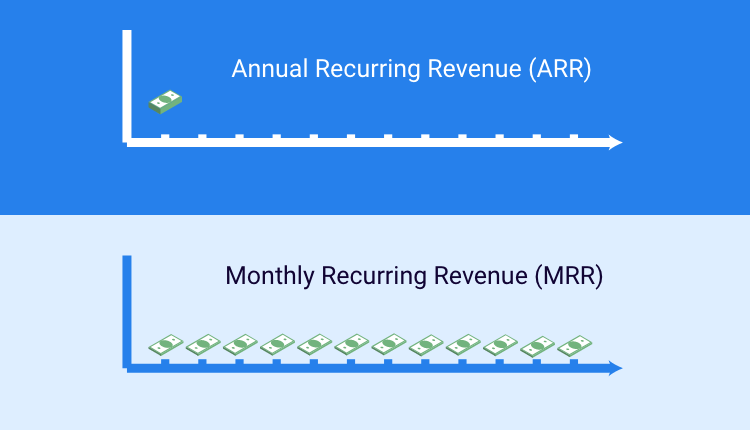What is Annual Recurring Revenue (ARR)?
Everything you need to know about Annual Recurring Revenue, presented by Replicon, the Time Intelligence® platform

We all know how effective subscriptions can be for growing companies, specifically for the SaaS industry. Perhaps one of the important reasons to implement this model is that it allows companies to circumvent one-time sales by guaranteeing a steady flow of revenue.
According to a report published by GlobeNewswire, the global subscription billing market size is estimated to reach USD 10,772.14 Million by 2025, at a compound annual growth rate (CAGR) of 16.02% from 2020.
With this trend towards subscriptions, it’s imperative for businesses to understand the metrics involved. And, for companies that rely heavily on subscriptions and upgrades, annual recurring revenue (ARR) is necessary to understand your financial growth.
Let’s dive deeper to understand what ARR is, how to calculate it, and how it’s useful for SaaS businesses.
What Is Annual Recurring Revenue (ARR)?
ARR is the total amount of expected revenue a business generates in a year from its customers by providing a product or a service. It is an important metric for quantifying a business’s growth, assessing its subscription model and assessing its revenue. Plus, it is equally important in determining a company’s growth in areas like sales, renewals or subscription upgrades, as well as its losses due to downgrades and cancellations.
How Do You Calculate ARR?
The simplest formula for calculating ARR is to add the total for yearly subscriptions to the revenue gained from add-ons and upgrades, and subtract the revenue lost from cancellations
In order to avoid inaccuracy while calculating ARR, any one-time cost or service fee should not be included.
Let us understand how ARR should be calculated in below scenarios:
For example, Customer A signs a contract for a service that will cost them $12,000 over the course of two years. The deal includes $2,000 for setup fees upfront. ARR = $6000 One-time fees are excluded, as explained. $12,000 / 2 year = $6000.
Customer B signs up for a $10,000, 1-year contract that has two distinct subscription components. Additionally, the client agrees to pay $5,000 for training. ARR = $10,000 Reason: One-time expenses are excluded. $10,000 / 1 year = $10,000. Usually, ARR is reported as an average across all sales items.
A customer signs up for a one-year contract with monthly payments of $1,000. ARR= $12,000 Explanation: It really doesn’t matter how the customer gets billed. The importance of the contractual commitment’s worth cannot be overstated. In this instance, the customer has a one-year contract worth a total of 12 x $1,000.
Further, some businesses prefer to break the total ARR into the following components, so they can better evaluate which segments are performing better:
- ARR generated from new subscribers
- ARR generated from renewal of existing subscribers
- ARR generated from upgrade of existing subscribers and from add-ons
- ARR lost from downgrade of existing subscribers
- ARR lost from the cancellation of subscriptions
What Is the Difference Between ARR and MRR?

MRR stands for monthly recurring revenue. It shows a business’s recurring revenue for a single month, which may change from month to month. MRR may differ due to variance in the number of days in a month.
The only difference between ARR and MRR is the period of time over which it is calculated – yearly or monthly. However, each metric is useful in different scenarios.
ARR should be the standard of revenue measurement for those businesses that have term agreements of one year or more. Note that the ARR metric can be misleading if the subscription is of non-standard lengths like 20 months, 25 months or just 14 days.
On the other hand, MRR should be the standard if customers pay month-on-month or have the option to cancel their subscription at any time or within the notice period.
Note that ARR is useful in annual board meetings and yearly performance reviews, whereas MRR is the preferred measure for monthly review meetings. It is also imperative to understand that the recognition of recurring subscription revenue through customer contracts is standardized and governed by the principles of GAAP included in Accounting Standards Codification (ASC) Topic 606.
How Is ARR Used?
ARR is the vital metric for subscription-based businesses to gain in-depth knowledge of their financial stability and yearly performance. Along with aiding in financial analysis, the ARR metric is also invaluable when determining a company’s future road map or when performing long-term planning.
In addition, ARR is useful for businesses in the following ways:
Aids in Business Health Assessment
ARR can graphically illustrate a business’s performance by showing revenue as an upward or downward graph. Further, by comparing ARR for several years, a company can clearly see whether or not its decisions are resulting in progress.
It Supports Revenue Projections
ARR is widely used for complex calculations that predict a business’s future cash flow and growth trajectory. Moreover, ARR that shows a negative trend can act as a red flag that helps the company understand where to take action.
It Helps Retain Top Performing Products and Features
Assessing ARR helps businesses understand which of their products and features is in sync with market demand and which ones need to change.
It Helps Companies Set Realistic Goals
ARR quantifies your company’s performance, enabling you to set more realistic goals for the future. It can help you identify the areas of greatest opportunity in your business model, so you know which actions will have the greatest impact on your bottom line.
It Draws in Investors
From the investor’s perspective, ARR plays a major role when evaluating a business stability and performance, since this metric can be directly compared to the ARRs of competing businesses, or it can be used to track a company’s performance over the years.
It Aids in Setting Long And Short Term Goals
ARR shows the areas of opportunity in a company’s current business model. For example, a company should focus on either upselling to existing customers or prioritizing acquiring new customers. It helps businesses be more realistic in setting long-term and short-term goals.
It Results in Better Budgeting
ARR is invaluable for planning the major expenses of a business. This includes spending on sales and marketing, new hires, purchasing or upgrading equipment, and planning the addition of new products and features.
An Example of ARR With Spotify
The music streaming company, Spotify, is one of the leading subscription companies around the world; it generated $9.85 billion revenue in 2021. But, without an understanding of how pricing strategies affect recurring revenue annually, this company would have had a tough time capturing the global market.
Let’s understand Spotify’s ARR calculation based on its subscription plans:
Spotify has 4 plans as mentioned below:
| Individual $9.99/month | Duo $12.99/month | Family $15.99/month | Student $4.99/month |
Let’s assume a customer, Neil, subscribes to the individual plan of $9.99/month and after 5 months, upgrades to the Duo plan, which is $12.99/month. Neil then keeps the Duo plan for the rest of the year, without canceling or downgrading.
The ARR calculated for his individual plan:
Total amount of yearly subscription: $9.99*12 = $119.88
Total amount gained through upgrading the plan = $3 per month for the remaining 7 months = $21
Total amount lost due to cancellation = 0
ARR = $140.88
Let’s say Neil upgrades to the Family plan of $15.99 after 5 months. The ARR calculation would be as follows:
Total amount of yearly subscription: $9.99*12 = $119.88
Total amount gained through upgrading the plan = $6 per month for the remaining 7 months = $42
Total amount lost due to cancellation = 0
ARR = $161.88
If Spotify has 75 customers like Neil who upgrade to Duo plan after 5 months, the ARR would be 75*$140.88=$10,566
This example shows how a subscriber’s choice, as well as the duration of the service, changes the ARR calculation for a business.
To understand the exact ARR of Spotify for all of its customers, the company needs to know all the subscriptions, upgrades, and downgrades within a year.
Frequently Asked Questions
1. What does ARR mean?
Annual Recurring Revenue (ARR) is a business metric that shows how much revenue a subscription-based business can expect to generate each year.
2. How do you calculate ARR for SaaS?
To calculate ARR, you simply add yearly subscription costs + recurring revenue from add ons and upgrades, and subtract revenue lost from cancellations. Or You can multiply MRR by 12.
3. What is the benefit of calculating ARR?
ARR is a good metric for evaluating a company’s growth over the years. By comparing and analyzing ARRs over time, a business can see whether their growth is trending upward or downward.
4. Is ARR the same as ROI?
ARR is not the same as ROI, in either its uses or its calculations. Return on Investment (ROI) is calculated by dividing the profit earned by the cost of that investment. For example, an investment with a profit of $200 and a cost of $200 would have an ROI of 1 or 100%.
